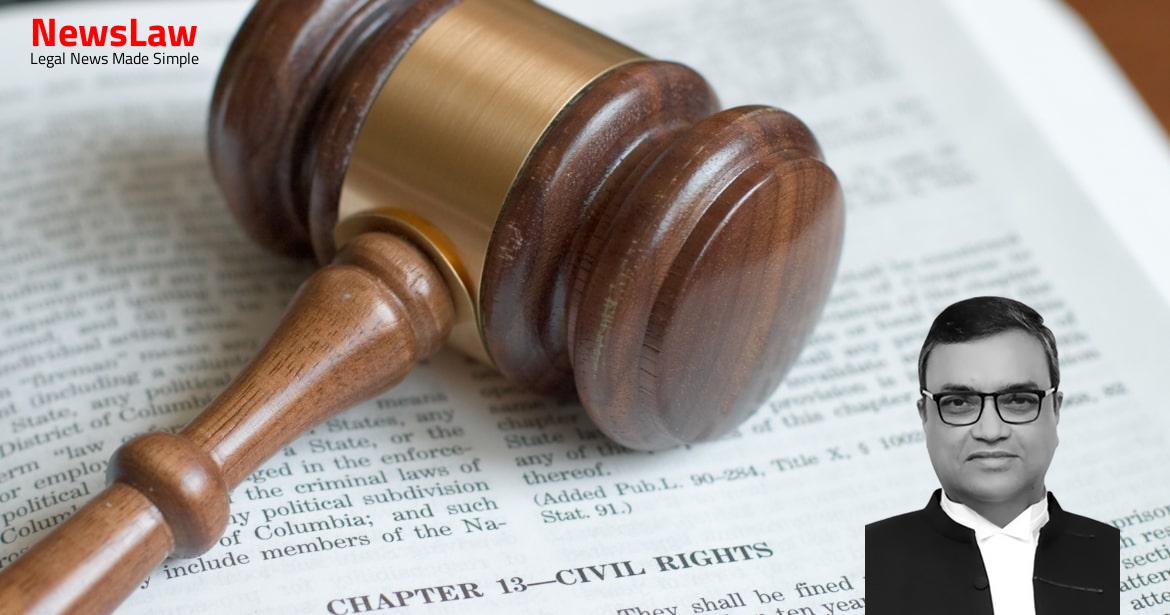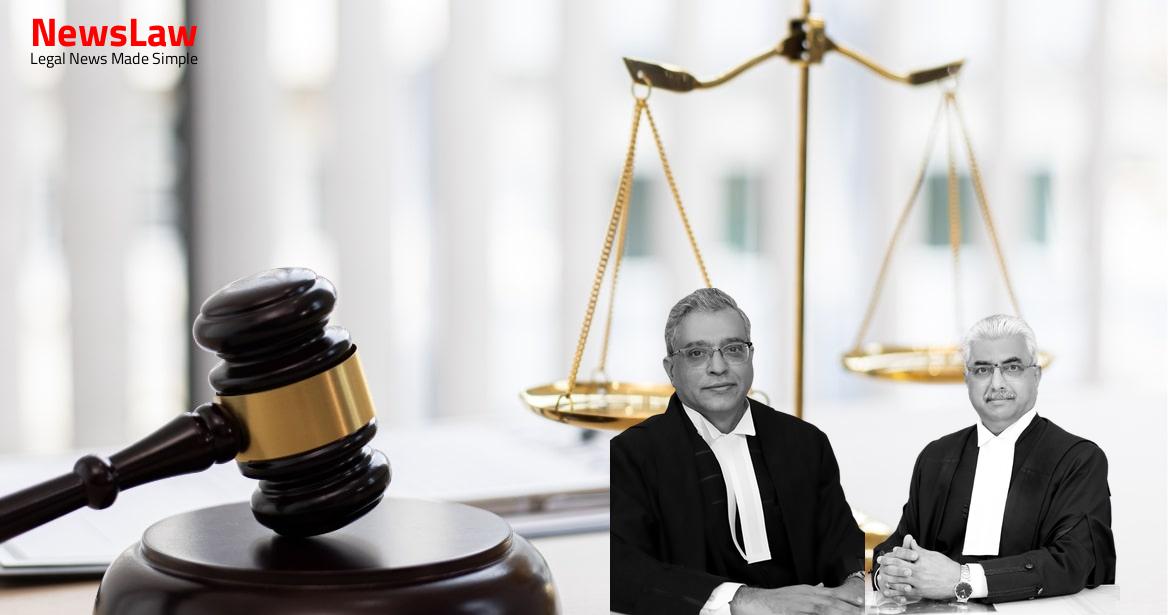…Respondents With Civil Appeal No 2312 of 2021 With SLP (C) No 23397-98 of 2018 With Civil Appeal
No 7318 of 2014 With SLP (C) No 81 of 2016 With Civil Appeal No 4398 of 2019 With SLP (C)
No 14176-77 of 2016 With SLP (C) No 27834 of 2017 And with SLP (C) No 1573-74 of 2021 2 J U D G M E N T Dr Dhananjaya Y Chandrachud, CJI Table of Contents A. Section 16(3) enunciates that a child of a marriage that is null or void or which is annulled by a decree of nullity shall not have “any rights in or to the property of any person, other than the parents” where but for the enactment of the legislation such a child would be incapable of possessing or acquiring any such rights “by reason of his not being the legitimate child of his parents”. This Court held that in view of the express mandate of the legislature in Section 16(3), a child born from a void marriage or a voidable marriage in respect of which a decree of nullity has been passed would have no right to inheritance in respect of ancestral or coparcenary property. After adverting to the two earlier decisions, this Court held that “a child born of void or voidable marriage is not entitled to claim inheritance in ancestral coparcenary property but is entitled only to claim a share in self-acquired properties.” 3.
The law has a socially beneficial purpose of removing the stigma of illegitimacy faced by children of such marriages, since the children themselves are innocent; (iv) The benefit of Section 16 (3) is available only when there is a marriage but the marriage is either void or voidable in view of the provisions of the legislation; (v) In the case of joint family property, children born from a void or voidable marriage will only be entitled to a share in their parents’ property but not in their own right: (vi) While the relationship between the parents may not be sanctioned by law, the birth of a child in such a relationship has to be viewed PART B 6 independently of such relationship. Section 11 stipulates that a marriage solemnised after the commencement of the Act shall be null and void and be so declared by a decree of nullity if (i) either party has a spouse living at the time of the marriage; (ii) parties are within the degrees of prohibited relationship except where a custom or usage governing them permits of a marriage; and (iii) parties are sapinda of each other, unless a custom or usage governing them permits of a marriage.
The manner in which Section 16 was drafted gave rise to two consequences: firstly, the status of legitimacy granted to a child born from a void or voidable marriage was conditional upon the marriage being annulled by a decree of annulment. Paragraph 2.36 of the Report elaborated that there were four possible premises to adopt, which were thus: PART B 10 The Law Commission noted that the legislature had adopted the third view. Interpreting the legal fiction in Section 16, the Court in Kalliani Amma observed that “illegitimate children, for all practical purposes, including succession to the property of their parents have to be treated as legitimate”. Under clause (b) where one of the parents professes any of the four religions, the child would be regarded as Hindu, Buddhist, Jain or Sikh, whether the child is legitimate or illegitimate. In contrast to sub-section (1), sub-section (2) embodies a deeming consequence of legitimacy, contingent on a decree of nullity under Section 12 where the child is “begotten or conceived” before the decree is made, if the child would have been the legitimate child of the parties to the marriage if it was dissolved instead of being annulled on the date of the decree. Parliament while enacting sub-section (3) intends to ensure that the legislative conferment of PART C 15 legitimacy will not confer upon such a child born from a void or voidable marriage as the case may be, “any rights in or to the property of any person other than the parents” where, but for the passing of the legislation, the child would have been incapable of possessing or acquiring any such rights by reason of their not being the legitimate child of the parents. Sub-section (3) implicitly recognizes that the child conferred with legitimacy by virtue of the provisions of sub-sections (1) and (2) would be entitled to rights in or to the property of the parents of the child.
This stipulation is, however, conditioned by the last part of sub-section (3) which provides that such a child would not have rights in or to the property of a person who is not a parent where but for the passing of the Act the child would have been incapable of possessing or acquiring such rights by reason of not being the legitimate child. The reference essentially raises the following issue: whether a child who is conferred with legislative legitimacy under Section 16(1) or 16(2) is, by reason of Section 16(3), entitled to the ancestral/coparcenary property of the parents or is the child merely entitled to the self-earned/separate property of the parents. Later, having dwelt on those precepts, the focus of the judgment will turn to the manner in which the HSA 1956 has (i) regulated the devolution of interest in coparcenary property; (ii) prescribed general rules of succession; and (iii) stipulated principles for the distribution of property. PART E 18
Also Read: https://newslaw.in/?p=652
On the other hand, according to the second formulation i) the property in the hands of the father after the partition from the larger coparcenary, is still coparcenary property belonging to the father as well as the children (who are per se considered legitimate); as such, it is not the ‘property of the parent’ as per Section 16(3), HMA and thus, the children under Section 16(3), have no right in it; ii) the intention of the legislature was merely to erase the stigma, and not to interfere with the structure of a coparcenary which does not include the children covered by Section 16; and iii) thus, under Section 16(3), the only right is with respect to the self-acquired/ self-earned property of the parent.
They cannot claim partition in the larger coparcenary, but once the larger coparcenary is partitioned- notionally or actually, and the property comes in the hands of the father, all his children – legitimate per se or legitimate by reason of S.16(3), have the same right in partition of this property in the hands of the father. Once a legal fiction is created, as has been created by Section 16(3), all inevitable corollaries thereof, including rights in the coparcenary property are also assumed. The latter part of Section 16(3) states- “ where but for the passing of this act, such child would have been incapable of possessing or acquiring any such rights by reason of his not being the legitimate child of his parents ”.
This distinction becomes clear through the decision in Jinia Keotin, where the court held that children covered by Section 16(3) have rights limited to their parents’ property. Initial HMA Provision (Section 16): The enactment of the Hindu Marriage Act (HMA) included Section 16, establishing children from void or voidable marriages as legitimate children their parents. Through various amendments, Parliament has ensured that these children possess inheritance rights within the scope of their parents’ property.
Traditionally, a Joint Hindu family comprises of male members who are lineal descendants from a common male ancestor, together with their mothers, wives or widows and unmarried daughters. The Court held that the incidents of a coparcenary are that: (i) The lineal male descendants of a person up to a third generation acquire ownership in the ancestral properties of such person; (ii) Such descendants can at any time work out their rights by seeking partition; (iii) Until partition, the ownership of every member of the coparcenary extends over the entire property conjointly with the rest; (iv) The consequence of such co-ownership is that possession and enjoyment of the properties is common; (v) No alienation of the property is possible unless it is for a necessity, without the concurrence of the coparceners; and (vi) The deceased member’s interest in a coparcenary lapses on his death in favor of his survivors. Narayan Rao Sham Rao Deshmukh, this Court while reiterating that a Hindu coparcenary is a narrower body than a joint family observed: PART F 26 The Court noted that the property of a joint family does not cease to belong to the family merely because only a single male member is left in the family. The interest of a coparcener is in that sense referred to as ‘an undivided coparcenary’ (see in this context, the decision of the Privy Council in Katama Natchier v. Section 6 however contained an exception where the deceased had left surviving a female relative specified in Class I of the Schedule or a male relative of the class who claimed through such a female relative in which case the interest of the deceased in the Mitakshara coparcenary property would devolve by testamentary or intestate succession of property under the Act and not by survivorship.
In that case, Khandappa, who had an interest in Mitakshara coparcenary property, died on 27 June 1960 leaving his wife Hirabai, his two sons, and three daughters.
This Court held that there was no justification to limit the share of the plaintiff to 1/24 by ignoring the 1/4 share which she would have obtained had there been an actual partition during her husband’s lifetime between him and his two sons. By the time that the Law Commission submitted its report, it noted that Andhra Pradesh, Tamil Nadu, Maharashtra, and Karnataka had incorporated amendments that would ensure that in a joint Hindu family governed by Mitakshara law, the daughter of a coparcener shall by birth become a coparcener in her own right in the same manner as a son (see paras 3.1 and 3.2.1). The Parliamentary amendment, as the Statement of Objects and Reasons indicates, “proposed to remove the discrimination as contained in Section 6…by giving equal rights to daughters in the Hindu Mitakshara coparcenary property as the sons have”. Section 6 (3) of the amended provision now stipulates that on “a Hindu” dying after the commencement of the amending Act, his interest in the property of a joint Hindu family governed by Mitakshara law devolves by testamentary or intestate succession, as the case may be, under the Act and not by survivorship. Prior to the amendment, the substantive part of Section 6 stipulated that the interest of a male Hindu in Mitakshara coparcenary property at the time of his death shall (i) devolve by survivorship upon the surviving members of the coparcenary; and (ii) not devolve in accordance with the Act. The principle of devolution by testamentary or intestate succession under the Act which was an exception prior to the Amending Act as set out in the proviso has now become the norm in sub-section (3) of Section 6. The Explanation to sub-section (3) mandates that the interest of a Hindu Mitakshara coparcener would be devolve on the basis that a partition has taken place of the property immediately before his death. Rule 2 of Section 10 stipulates that “the surviving sons and daughters and the mother of the intestate shall each take one share”. Such a construction shall also accord with the provisions of sub-Section 3 of Section 16 of the HMA 1955 PART G 38 which enunciates that the conferment of legitimacy by sub-Section (1) or sub- Section (2) shall not confer on a such a child “any rights in or to the property of any person, other than the parents.” 40.
The Explanation to sub-Section (3) of Section 6 postulates that a notional partition has taken place immediately prior to the death of the coparcener and his interest is deemed to be the share that would have been allotted to him in such a partition.
When a Hindu dies after the commencement of the Amending Act of 2005, his interest in the property of a Joint Hindu family governed by Mitakshara law has to devolve by testamentary or intestate succession and not by survivorship, as stipulated in sub-Section (3) of Section 6. Hence, where the deceased has died intestate, the devolution of this property must be among the children – legitimate as well as those conferred with legitimacy by the legislature under Section 16(1) and 16(2) of the HMA 1955. Sub-section (3) of Section 6 indicates by a deeming provision what would constitute the interest of a Hindu Mitakshara coparcener. As already discussed, the deeming fiction requires an assumption of a hypothetical state of affairs in terms of which a notional partition is deemed to have taken place immediately before the death of the Hindu Mitakshara coparcener. The widow would take a 1/3 share (her share in the notional partition) plus 1/3 in the 1/3 share of C2 (her share in succession, as an heir to C2). It has been submitted before us that the child who is conferred with legitimacy under Sections 16(1) and Section 16(2), would not have a share in the partition of the ‘larger coparcenary’ but would have a share in the coparcenary that comprises of the child’s father and the father’s legitimate children. As such, the property, once partitioned from the larger coparcenary, and in the hands of the father, for his own branch, is not the father’s separate property, until the partition happens within the branch.
It is important to notice that while Section 16(1) and Section 16(2) of the HMA confer legitimacy on children from void or voidable marriages, sub-section (3) has circumscribed the extent of the right to or in property that would be enjoyed by a person who has statutorily been conferred with legitimacy under sub-sections (1) and (2). The individual upon whom legitimacy has been conferred by Section 16(1) or Section 16(2) of the HMA 1955 would be entitled to a share in the property that would have been allotted to their parent assuming a notional partition immediately before the death of the parent. When Section 6 was substituted by Act 39 of 2005, Parliament was aware of the substitution of Section 16 of the HMA 1955 by Act 68 of 1976 with effect from 27 May 1976. Once legitimacy has been conferred upon such an individual under sub-section (1) or sub-section (2) of Section 16 of the HMA 1955, the proviso to Section 3(j) which deals with “illegitimate children” ceases to apply to children covered under Section 16(1) and Section 16(2). Justice R A Jahagirdar speaking for the Division Bench observed: PART I 46
The Division Bench held that children born of a void marriage and who are regarded as legitimate by virtue of the provisions of Section 16 of the HMA are entitled to the rights conferred upon them by Section 16(3) “irrespective of the apparent restricted definition of Section 3(1)(j) of the Hindu Succession Act”. As a result of the substitution of Section 6(3), devolution of the share of a Hindu male coparcener in the property of a HUF governed by Mitakshara law upon death takes place not by survivorship but by testamentary or intestate succession, as the case may be, under the Act. Section 17 stipulates that any marriage between two Hindus solemnized after the commencement of the Act is void if at the date of such marriage, either party has PART I 48 a husband or wife living. As a result of the statutory prohibition on bigamy, and the nullity of such marriages in the eyes of the law, a child born to parents in a void marriage was deprived of the legitimacy that they enjoyed under the traditional Hindu law. Section 16(3) represents a balancing act by the legislature when it stipulates that a child who is legitimate in terms of sub-sections (1) or (2) of Section 16 would have rights in or to the property only of the parents and not of any other person.
Case Title: REVANASIDDAPPA Vs. MALLIKARJUN
Case Number: C.A. No.-002844-002844 / 2011



